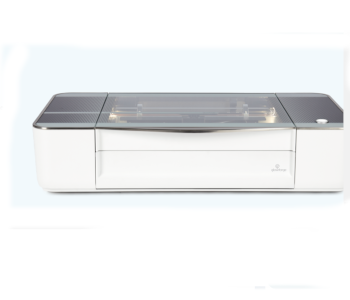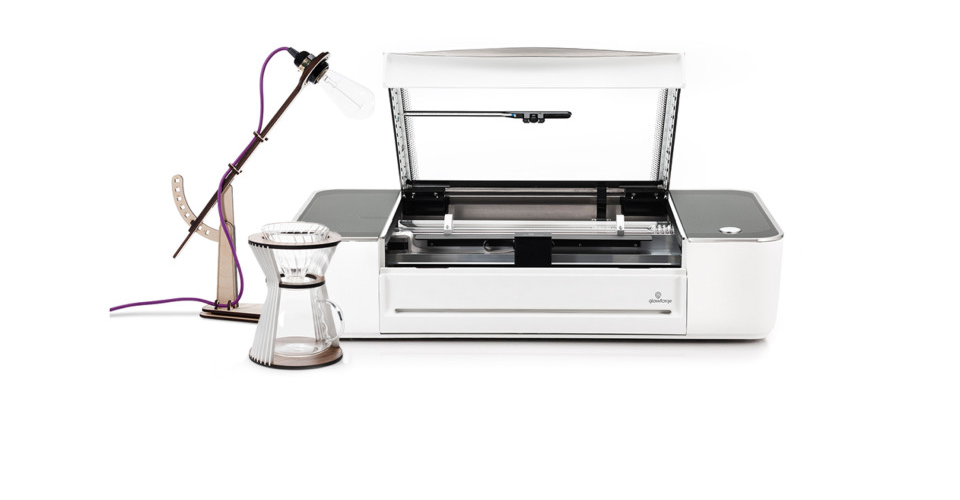Budget-Friendly Laser Cutting: A Review of the Glowforge Basic
Although we’ve written a lot about how laser cutting and marking technology may revolutionize manufacturing, there’s no question that the technology remains quite expensive. This is only one of several hurdles that laser manufacturing has to overcome to achieve mainstream adoption.
Glowforge seeks to address this gap by offering laser cutting equipment that is compact enough for small workspaces and is relatively affordable. If you need to buy a laser cutter on a budget, then the Glowforge Basic is one of the best options available today. How does the Glowforge Basic fare? Is it a worthwhile introduction to the bigger world of laser cutting?
Overview
Seattle-based Glowforge is a company that aims to make laser cutting and engraving technology more accessible to a wider audience. They got their start through a crowdfunding campaign back in 2015 where they managed to raise over $28 million. Today, Glowforge specializes in laser cutting machines that are more compact, cheaper, and easier to use compared to similar offerings in the market.
Right now, Glowforge offers three models of their desktop-scale laser cutters. The most inexpensive model is the Glowforge Basic, which starts at $2495. They also have more premium models – the Glowforge Plus and the Glowforge Pro. Although not exactly cheap, the Glowforge Basic is probably one of the most affordable desktop-scale laser cutters that you can buy today.
Design and build quality

The design aesthetic of the Glowforge Basic is in line with most modern devices – sleek, elegant, and minimalist. The simple white and gray color scheme is reinforced by the use of high-quality metal, glass, and plastic on the machine’s body. To the untrained eye, the Glowforge Basic will look just like a standard large-format printer.
Speaking of size, the Glowforge Basic is pretty bulky with dimensions of 8.3 x 38 x 21 inches. This is a good thing, of course, as it also means that the Glowforge Basic can accommodate large workpieces. The main cutting area measures 11 x 19.5 inches and is enclosed by a glass door at the top and a metal door at the front. Both doors can be opened to access and place workpieces in the cutting area.
The cutting area has a removable tray that slides in and out which serves as the mounting area for the workpiece and a catch basin for any dust and crumbs from the cutting process. A honeycombed pattern on the baseplate enhances heat dissipation.
Unlike the Glowforge Pro, the Basic model has no feeder slot which limits the size of workpieces it can accommodate. According to Glowforge, the maximum build area for the Glowforge Basic is about 18 x 20 square inches.
At the heart of the Glowforge Basic is the 40-Watt CO2 laser tube, which Glowforge designed in-house. It is a compact laser with a high power density. The laser is mounted on a metal arm which is free to move along a fixed track in all four directions. Auto-adjusting optical equipment on the laser reduces the need for work-intensive and error-prone manual intervention.
To provide monitoring while a project is in progress, two cameras are mounted on the interior section of the cutting area. A wide-angle camera is located on the lid which offers an overall view of the cutting area while a smaller macro camera on the laser head gives a closer look at the details being created.
Safety is a significant element of the design of the Glowforge Basic. Aside from construction that promotes heat dissipation, the Glowforge Basic comes with a built-in closed-loop water cooling system and a compressor that exhausts to a vent at the back of the machine. This vent can be connected and redirected via a flexible tube. This allows for the removal of both heat and particulates from the cutting area.
Glowforge also sells an optional Compact Filter box add-on which can be connected to the laser cutter’s exhaust vent. The Compact Filter comes with an intake fan and a filter cartridge for the active removal of particulates.
Interface
Most of the functions of the Glowforge Pro are accessed via the companion web app, so there are only a few physical controls on the machine itself. Aside from the main power switch, which is right next to the power connector, a single circular button is the only physical control mechanism you’ll need to take note of.
The main button sits on the top panel and doubles as a visual indicator of the machine’s status. The button glows teal during setup and turns white once the cutter is ready to start a project. Simply press the button to start cutting or do a long press to go back to setup mode. On the cutting area are two LED indicators that light up the workpiece, allowing you to monitor the progress of the project.
The minimalist physical interface works really well with the modern design of the Glowforge Basic. It preserves a sleek look while reducing the clutter and streamlining the user experience. As we shall see later, the lack of physical buttons does not reduce the capabilities of the Glowforge Basic at all.
Setup
The printer comes almost fully assembled when it ships. The additional setup work only takes a few minutes. All you need to do is to mount the laser head to the moving arm inside the cutting area using the convenient magnetic connector and connect the appropriate ribbon cables.
From this point, you can plug in and activate the printer. You’ll then need to run the web-based Glowforge app and make sure that both the app and the laser cutter are connected to the same Wi-Fi network. Sending of files to the laser cutter and setting of parameters will be done through the app.
Cutting performance
The cutting element of the Glowforge Basic is a 40-Watt CO2 laser. This is a lower wattage rating compared to the Pro version, which means that the Basic cuts at about half the speed. The total time it takes to complete the project in the Glowforge Basic will vary greatly based on the size of the piece and the level of detail, but it typically falls within the 1 to 3-hour range. However, the Glowforge Basic is capable of running for 7 hours continuously given optimal cooling.
In terms of output quality, the precision and sharpness of the cuts that Glowforge Basic makes are stellar. Cuts and engravings come out clean and smooth, although char marks can still be apparent when the laser intensity is set too high. The cutter also has limitations in resolution, so very small details can turn out to be indistinct.
The Glowforge Basic offers Draft, SD, and HD pre-set output resolution settings. Draft mode can be useful if you’re in a hurry or if you just want a quick sample of a design, while leveling up to HD may be the best option for making the final output. Engraving of photorealistic designs is within the capabilities of the Glowforge Basic, but massive pre-processing may be needed to make sure that the source image has enough contrast.
All Glowforge cutters are designed to work with a huge variety of materials including wood, metal, acrylic, leather, glass, stone, and ceramic. Through the app, users can conveniently choose from more than a dozen pre-set laser parameters for each type of common material.
Users can also buy Proofgrade materials from Glowforge which are basically sheets of raw material with QR codes. Scanning these QR codes allows the cutter to identify the material and automatically set the most optimal laser parameters. The Proofgrade sheets are a bit expensive, though, at around $100 per sheet.
Software
The more advanced controls for the Glowforge Basic are accessible via their cloud-based software. The software is compatible with any one of the iOS, Windows, Android, or Linux platforms. Since the app connects to a local Wi-Fi network, an internet connection is needed to use the laser cutter.
The software itself is quite intuitive and easy to use. It accepts bitmaps for etching projects and vector graphics for cutting. Size alteration can be done through simple drag and drop controls. It’s also possible to make multiple cuts or etches in a single workpiece by arranging reference files in multiple layers.
Through the app, the user can monitor the progress of the project through the built-in cameras.
As with any new software, using the Glowforge app will require overcoming a significant learning curve. However, the learning process isn’t too hard especially for those who have backgrounds in working with images or 3D models.
Is the Glowforge Basic worth it?
The Glowforge Basic costs $2495. While laser cutters from industrial brands like Epilog are certainly a lot more expensive, there are also cheaper options that cost anywhere between $1000 to $2000 from Chinese brands. The real question is – is the Glowforge Basic worth its price?
The Glowforge Basic has been in the market for more than two years, various industry experts and hobbyists have spent a lot of time with it. Based on their collective experience, it’s safe to say that the Glowforge Basic offers very good value for money.
Glowforge Basic offers a very easy and intuitive user experience in a laser cutter with a compact footprint and a sleek, modern design. Its build quality is impeccable and similar to more expensive laser cutters. As with all the good laser cutting and engraving machines out there, the Glowforge Basic is compatible with a wide range of materials.
Although there are alternatives to the Glowforge Basic that are a little cheaper, its technology and level of quality is more than enough to justify the price. If you’re thinking of using the Glowforge Basic to start or augment a business, the machine should pay for itself quite quickly.
Final thoughts
There are few products available today that can directly compete or even compare with the Glowforge Basic, even though it’s been in the market for quite some time. This is a desktop-scale laser cutter and engraver that has been intelligently designed to have all the essential features typically found in industrial-grade counterparts.
Glowforge has been at the forefront of developing laser cutting and engraving technology for use in desktop-scale environments. Aside from the Glowforge Basic, we will also be looking at the Plus and Pro versions in future articles.

